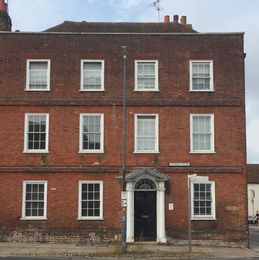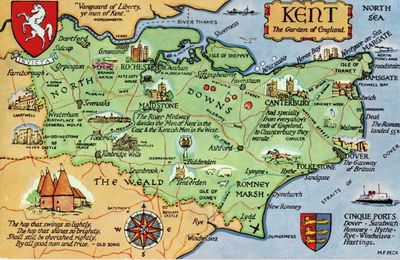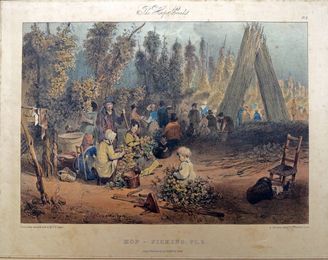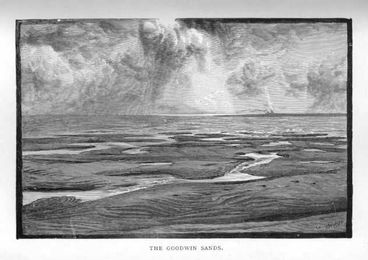ve-header title="20th Century Kent" background=gh:kent-map/images/banners/20c.jpg .sticky
Dover and Folkestone become the gateway to the Western Front during WW1. Seaside towns decline, challenged by the increasing popularity of overseas holidays.
People
.cards
H.E. Bates
H.E. Bates

Herbert Ernest Bates (1905-1974), a newspaper reporter originally from Northamptonshire, became well-known for his 1958 novel Darling Buds of May, which centred around the Larkin family and their adventures in rural Kent.
Edmund Blunden
Edmund Blunden

‘Two influences stand out clearly and unmistakably; that of Kent, his native countryside, and that of the war. Mr Blunden is a thorough Kentishman. That probably is why he succeeds so admirably in recreating the very soul and atmosphere of the southern counties.’
Elizabeth Bowen
Elizabeth Bowen

‘Possibly it was England made me a novelist’ Elizabeth Bowen loved East Kent. When she was uprooted from Ireland and transplanted to the Folkestone area as a child of seven she was immediately bewitched.
Jocelyn Brooke
Jocelyn Brooke

Jocelyn Brooke spent most of his life in the little village of Bishopsbourne, 5 miles south-east of Canterbury, concealed like a secret in the Elham Valley. He remains an obscure and neglected figure, best known, if at all, for The Orchid Trilogy
Alfred Cohen
Alfred Cohen

In 1963, Cohen and his second wife Diana were looking for a studio. They drove past a striking coach house of a grand Queen Anne-style red-brick mansion called Ballards, on the road to Horsmonden.
Amy Johnson
Amy Johnson

Amy Johnson (1903-1941), CBE, was a record breaking pilot and engineer, most famous for being the first woman to fly solo from England to Australia in 1930.
Baroness Orczy
Baroness Orczy

Born in Hungary in 1865, Emma Orczy de Orci, the author of the Scarlet Pimpernel novels moved to Thanet in 1908 with her husband, the illustrator, Montague Barstow.
Bertha Porter
Bertha Porter

Bertha Porter, biographer, and Egyptologist was born in Bloomsbury on April 9th, 1852. In the 1870s, Bertha’s parents, Frederick and Sarah Porter (nee Moyle), bought a seaside home on Marine Terrace, Hythe.
Christopher St John
Christopher St John

Christopher St John (born Christabel Marshall) was a prolific writer whose work covered biography, suffrage and avant garde plays, experiments in life writing, and over thirty years of journalism for British newspapers and magazines.
Cicely Hamilton
Cicely Hamilton

Cicely Hamilton was a feminist actress, writer and playwright. She co-founded the Women Writers’ Suffrage League and was a vigorous campaigner for women’s suffrage.
D.H. Lawrence
D.H. Lawrence

David Herbert Lawrence, a coal miner’s son and struggling writer from Nottingham, visited Kent in the autumn of 1911. He had sent two short stories to critic and literary editor Edward Garnett who invited him to stay at his home The Cearne at Crockham Hill, Edenbridge.
Daphne Oram
Daphne Oram

Born in 1925, Daphne Oram, pioneer of electronic music, turned down a place at the Royal College of Music in 1942 to become a Junior Studio Engineer and ‘music balancer’ at the BBC.
Derek Jarman
Derek Jarman

Derek Jarman, painter, poet, film-maker, was born in 1942 in Northwood, Thanet. He fell in love with Dungeness in general and Prospect Cottage in particular when a desire for fish and chips brought him to Romney Marsh in 1986 at the age of 44.
Diana & Tony Powell
Diana & Tony Powell-Cotton

Diana Powell-Cotton (1908-1986) & Tony (Antoinette) Powell-Cotton (1913-1997), arguably the first British women documentary filmmakers, travelled to the interior of Africa in the 1930s where they recorded the domestic lives of those they met and lived with.
Donald Maxwell
Donald Maxwell

Donald Maxwell, enlisted as a Royal Naval Volunteer Reserve and posted to North Sea Patrol at Sheerness during WW1. Post war, he lived in Borstal, near Rochester.
E.M. Forster
E.M. Forster

In 1893 E.M. Forster and his mother moved to Tonbridge where they rented ‘Dryhurst’ in Dry Hill Park Road so that Forster might attend Tonbridge School as a day boy.
Edith Craig
Edith Craig

Edith ‘Edy” Craig was a trailblazing theatrical director, producer, costumier and actress. She was also committed to the fight for equality for women and, as an extension of that, to the cause of women’s suffrage.
Elizabeth Von Arnim
Elizabeth Von Arnim

Elizabeth von Arnim (31 August 1866 – 9 February 1941), born Mary Annette Beauchamp, was an English novelist. She undertook a caravanning holiday in Sussex and Kent in the summer of 1907.
Ellen Terry
Ellen Terry

Ellen Terry was the superstar English actress of the Victorian period. Born to a theatrical family, she is best known for her long theatrical partnership with Sir Henry Irving, performing at the Lyceum Theatre, London, and throughout the UK and the US.
Ford Madox Ford
Ford Madox Ford

Ford, originally named ‘Ford Hermann Hueffer’, eloped, in 1894, with his childhood sweetheart Elsie Martindale, and they moved to the Romney Marsh, where Ford lived until they gradually separated from 1907-09.
Gladys Waterer
Gladys Waterer

Gladys Waterer was best known in her lifetime as a dramatist and leading light of the Broadstairs branch of the Dickens Fellowship from its inauguration in 1837.
H.G. Wells
H.G. Wells

On medical advice, wells and his wife Jane moved to the Kent coast at Sandgate where the writer had many connections to other authors who spent time in and wrote about Kent.
Ian Fleming
Ian Fleming

Fleming’s fondness for Kent flowered from its roots as an occasional golfing retreat to what was to become, for a time, a blissful domestic haven. With so much invested in Kent it was natural for Fleming to mine it as a source for what was to become his career as a writer.
J.G. Sarasin
J.G. Sarasin

Nora Geraldine (Gerry) Gordon Salmon, a popular historical fiction writer of the 1920s-1960s, lived in Canterbury and Harbledown for much of her career.
John Ferguson
John Ferguson

Scottish by birth, novelist and dramatist John Ferguson became chaplain of Eversley girls’ school in Sandgate in 1915. The following year he wrote a paper for the Folkestone War Refugees Committee on the town’s contribution in helping Belgian refugees.
Julian Symons
Julian Symons

Julian Symons was a poet and a prolific author of both history and crime fiction. In 1951 he was elected the first Jewish member of the Detection Club, becoming President in 1976 and also President of the Conan Doyle Society in 1979.
M.R. James
M.R. James

Medieval scholar and ghost writer, Montague Rhodes James was born at Goodnestone Parsonage in August 1862. An eminent academic, he was also Director of the Fitzwilliam Museum in Cambridge and a Fellow of the British Academy.
Marian Fielding Peck
Marian Fielding Peck

Marian Fielding Peck (always known as Maisie) started painting seriously in the 1920s and, as well as map designs, she also specialised in calligraphy and miniatures, some of which were exhibited at the Royal Academy.
Mary Kelly
Mary Kelly

Writing in the 1950s and 1960s, Mary Kelly (1927-2017) was an English crime writer best known for the Inspector Brett Nightingale series. She wrote her novel ‘Due to a Death’ following a holiday to Greenhithe, Kent.
Mary L. Pendered
Mary L. Pendered

Mary Lucy Pendered, who is remembered as the author of ‘coy pastoral tales’ spent several years in Herne Bay, where she was the President of the local branch of the National Union of Women’s Suffrage Societies.
Mary Tourtel
Mary Tourtel

Rupert Bear is a children’s comic strip character first published on the 8th November 1920 in the Daily Express newspaper. He was created by the Canterbury-born illustrator Mary Tourtel and thus became firmly rooted within the public vision of the city’s literary heritage.
Noel Coward
Noel Coward

From a young man, already with some career success, Sir Noël Peirce Coward (1899-1973) lived in and was part of the literary circle of East Kent for several decades before relocating to the West Indies.
Pamela Wynne
Pamela Wynne

Both romance and crime fiction flourished in the 1930s holiday market, and Margate on the East coast of Kent provided an obvious setting for middlebrow fiction.
Paul Nash
Paul Nash

Paul Nash was a war artist and photographer and an important influence in British inter-war surrealism and Modern Art. He moved to Dymchurch, suffering post-traumatic stress disorder after World War One, where he recuperated whilst repeatedly painting seascapes.
R. Austin Freeman
R. Austin Freeman

Doctor and pioneering crime writer R. Austin Freeman is widely credited with the invention of the ‘inverted’ crime story and lived in Kent with his wife Annie and their two children after being invalided out of the Colonial Service in 1891.
S.C. Nethersole
S.C. Nethersole

Susie Colyer Nethersole, author of rural fiction, was born into a farming family in 1869 at Goodnestone where her father farmed 220 acres.
S.E. Winbolt
S.E. Winbolt

Holidaying in Folkestone in 1923, Samuel Edward Winbolt, a classics and history teacher, learnt of a site of archaeological interest on the East Cliff and was to spend the next two holidays excavating the remains of a Roman villa.
Siegfried Sassoon
Siegfried Sassoon

Alongside his friend and protégé Wilfred Owen, Siegfried Sassoon (1886-1967), who was born in Matfield, Kent, is one of the most widely read poets of the First World War.
Somerset Maugham
Somerset Maugham

Playwright, novelist, and short story writer Somerset Maugham was one of the most popular writers of the inter-war period. Born in Paris, Maugham attended the King’s School in Canterbury which features in several of his stories.
T.S. Eliot
T.S. Eliot

Herbert Ernest Bates (1905-1974), a newspaper reporter originally from Northamptonshire, became well-known for his 1958 novel Darling Buds of May, which centred around the Larkin family and their adventures in rural Kent.
U.A. Fanthorpe
U.A. Fanthorpe

Fanthorpe’s childhood spent in Bromley would become significant to her work in later life. With her brother David, she spent time exploring Kent by bicycle and stopping at historical sites.
Victoria Holt
Victoria Holt

Victoria Holt, a prolific and popular author who was a pioneer of the genre known variously as the modern Gothic novel, Gothic romance or romantic suspense.
Vita Sackville
Vita Sackville-West

A prolific and versatile writer and poet, Sackville-West is perhaps best known today as a gardener, for her unconventional marriage, and as the inspiration for Virginia Woolf’s Orlando.
Walter James, the fourth Lord Northbourne
Walter James, the fourth Lord Northbourne

Walter James (1896-1982), the fourth Lord Northbourne, is credited with coining the term ‘organic farming’ in his seminal 1940 work Look to the Land. Eighty years on, his ideas still have freshness and immediacy.
Wilfred Owen
Wilfred Owen

Celebrated war poet, Wilfred Owen, twice passed through Folkestone on his way to the Western Front.
William Pett Ridge
William Pett Ridge

William Pett Ridge, writer and ‘friend of the cockneys’ was born at Chilham, near Canterbury on 22 April 1859. His novels include small vignettes of Kentish life which reflect his knowledge of the county.
Places
.cards
Canterbury
Canterbury

Canterbury, with its Cathedral, founded 597 A.D. was a pilgrimage site in the Middle Ages. Ancient walls, originally built by the Romans, encircle its medieval centre with cobbled streets and timber-framed houses.
Folkestone and World War One
Folkestone and World War One

The outbreak of war in August 1914 led to a transformation of this genteel resort. Folkestone, with its port and excellent rail and road links, became the main point of embarkation and return for the battlefields of France and Flanders.
Gravesend
Gravesend

As a modern transport hub, Gravesend, is home to the Port of London Health Authority, and the Trinity House, Thames River pilots. The town grew considerably in the 19th century as a watering place, and the Royal Terrace Pier and public gardens were opened.
Richborough: The Secret Port
Richborough: The Secret Port

Due to its location, the old Roman port of Richborough, at the mouth of the Wantsum channel, was chosen for development as a ‘secret port’ during World War I.
The Secret War Tunnels of Dover Castle
The Secret War Tunnels of Dover Castle

During the Second World War, Dover Castle played a vital role in the strategic operations of the British Army and its secret network of seven tunnels was home to the only underground barracks in the country.
Winston Churchill - Chartwell
Winston Churchill

War-time Prime Minister Winston Churchill has several connections to Kent. Most importantly he was a resident of Kent, living at Chartwell, a country house near Westerham.
Events
.cards
Belgian Refugees
Belgian Refugees

As many as 250,000 Belgians from all layers of society sought refuge in Britain after the fall of Antwerp on 6 October 1914. Many were exhausted and few spoke English.
Doodlebugs in Kent
Doodlebugs in Kent

The year 1944 was one of devastating human loss for Kent, in part due to the impact of a newly invented ‘revenge weapon’ used by the Germans, the V-1 flying bomb, also known as the doodlebug.
Ellen Terry’s funeral
Ellen Terry’s funeral

In the days before the great Victorian actress Ellen Terry died on 21 July 1928, the nation had been on tenterhooks for news of her health and an efficient ‘news bureau’ had been set up in her house at Smallhythe Place.
Hop Picking and the Literary Imagination
Hop Picking and the Literary Imagination

To this day the autumn hop picking season provides a potent image of Kent rural life. In the nineteenth and twentieth centuries, workhouses were considerably less busy at this time as families and people of all ages were able to participate.
The Great Storm of 1987
The Great Storm of 1987

On 15 October 1987 weather forecaster Michael Fish had no idea that he would become famous just for saying there would not be a hurricane that night. Hours later the worst storm since 1703 hit the UK.
Kent Coal Mining
Kent Coal Mining

Coal was first discovered in East Kent in 1890, while Betteshanger was the last pit to close in the Coalfield in 1989. The in-between history is important, complex and contested.
Texts
.cards
Rupert Bear by Mary Tourtel
Rupert Bear by Mary Tourtel

Rupert Bear was first published in 1920 in the Daily Express newspaper. He was created by the Canterbury-born illustrator Mary Tourtel and became firmly rooted within the city’s literary heritage.
Shepherds in Sackcloth by Sheila Kaye-Smith
Shepherds in Sackcloth by Sheila Kaye-Smith

Author Sheila Kaye-Smith was dubbed the ‘Sussex Hardy’ in the 1920s, but this in no way constrained her fluid use of geography when it came to locations for her novels.
Double Double by John Brunner
Double Double by John Brunner

Notes on the landscape might seem extraneous given all the other details but one of the best things about the Double Double by John Brunner is its descriptions of the Kent countryside.